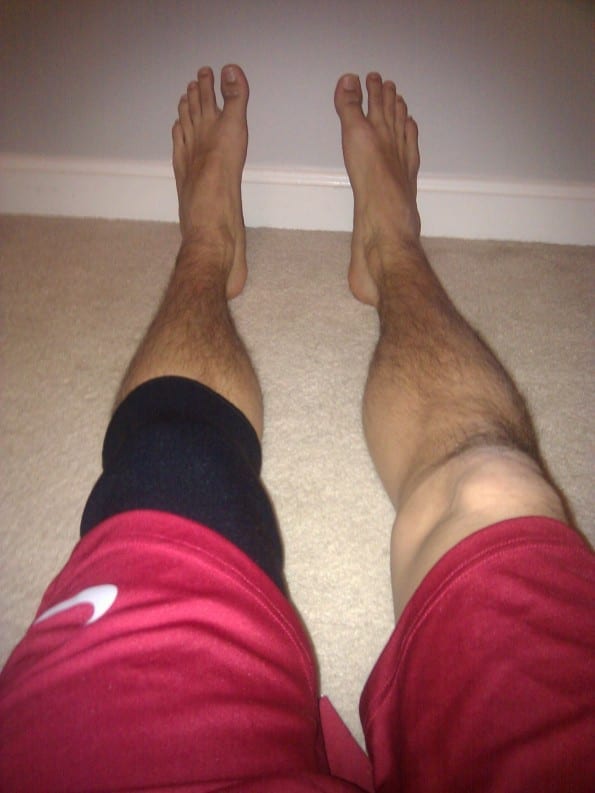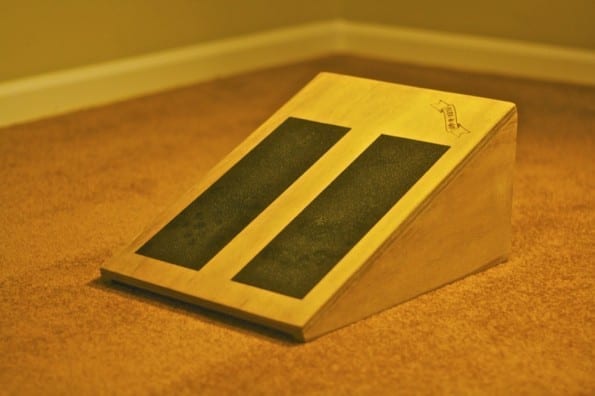How to Know if You Have Tendonitis in Your Knee
I've been contesting chronic Patellar Tendonitis (aka 'Jumpers genu' and some forms of 'Runners human knee') for over two years now. I've written before about my problem in a post almost Egoscue therapy, as I was exploring that as a treatment option for my ailment. Ultimately that wasn't the right treatment for me, but I practice now think I've stumbled upon a surprisingly simple 'hack' that has a profound impact on Patellar Tendonitis.
Being Diagnosed with Patellar Tendonitis
Before I get into my little discovery, first some backstory on my problem: Most two years ago my knee felt really stiff afterward a playoff softball game. There was no pop or pain during the game, I but noticed some tenderness and hurting when I pushed off. I figured it was no large bargain and that it'd go abroad in a few days like nearly other small injuries, just information technology didn't.

Sporting a knee caryatid to keep my knee joint warm and 'restricted' during sports. I really wanted a treatment to brand the injury go away, not just treat the symptoms.
After giving it a few weeks, I decided to make an engagement at the family unit doctor to see what was up. He did some remedial tests and diagnosed me with Patellar Tendonitis. He sent me habitation with a printout of some stretches and exercises I could practice to brand information technology get abroad, only those unfortunately didn't aid at all. To make a long story short, I doubted the family doctor and went to encounter an orthopedist who specializes in knees. An x-ray and MRI later, the family doctor's diagnosis was confirmed (pitiful for doubting, Dr. Cohn!).
Trying Dissimilar Handling Options
Ok, so I'm gonna wrap upward this backstory. I don't want to get surgery; Patellar Tendonitis does non take a good runway record of getting cured via surgery. So I've been exploring and testing all my options… literally all of my options. These are my tests thus far:
-
-
- 8 Weeks of Physical Therapy – unfortunately this didn't assist, and it wasn't fully covered by my insurance, so it was pricey for something that brought about no change
- Iontophoresis – These are little patches that utilise electricity to put cortisone deep into the tendon. These did save pain temporarily (4-24 hours), but there was no long-lasting improvement
- Cortisone Injections – the relief from these injections were instant, but lasted only 8-12 hours. I know these are a miracle drug for some, merely information technology was only a superficial healing for me and it faded away rather apace.
- Prolotherapy – This is like to PRP (beneath)… basically they inject a glucose solution into the trouble expanse. The theory behind this is that the solution irritates that surface area so much, that the body sends new (and lots) of claret to the injury, thus restarting the healing process. Sounds good in theory, and at that place are a lot of people who claim to have had astonishing success with this, simply no such luck for this guy.
- Platelet-Rich Plasma (PRP) – I just did this once, and then I can't requite a fair review hither. This treatment is really popular right now, and y'all'll hear a lot of professional athletes (Tiger Woods, Troy Polamalu, LaRon Landry) talking about the success they had with it . What they did is describe my blood, so that blood went through several spin processes to split the plasma from everything else. Finally just the plasma was injected back into me, but this fourth dimension directly into the problem expanse of the knee. This was really, really painful for the first 24 hours. The plasma seriously irritates the knee, and information technology injure. I decided a few months afterward that I was going to put this handling choice on agree and explore a few other things commencement. I haven't completely abandoned it, I'm merely non so sure it'southward the right solution here.
- Egoscue – I mentioned that I was trying this out, but ultimately I couldn't go along upwards with the demand of following my 'e-cises' 4-5 a calendar week, at an 60 minutes each mean solar day. I practise think that Egoscue is great for improving posture and overall health, but I'g not so sure that it is a specific tool for healing this precise injury.
- Cissus – I read about this in the 4 Hour Trunk book past Tim Ferris (which is neat, by the way). Information technology didn't work for me, only I didn't have loftier hopes for it anyhow.
-
So all of those treatments, no solution, yet painful Patellar Tendonitis. No running, ofttimes fitful sleep, discomfort when sitting down (think driving, aeroplane rides, and even but relaxing on the couch), just general restlessness as I'grand ever searching for the next comfy position to put my leg in.
Finding the Clandestine?
While doing some other scan online, I stumbled beyond a written report that compared the healing results of eccentric exercises vs surgery in treating and defeating Patellar Tendonitis. Their decision?
No advantage was demonstrated for surgical handling compared with eccentric strength training. Eccentric preparation should be tried for twelve weeks earlier open tenotomy is considered for the treatment of patellar tendinopathy.
The eccentric part of an practise is the office when yous are elongating the muscle, non contracting. For instance, in a button-upward, the eccentric role is when you are lowing yourself downwardly. This study and another literature seem to betoken to a healing ability that eccentric exercises can have for this injury.
Connecting with the Flex-North-Become Founder
I figured this was absolutely worth a shot. The eccentric practice for the genu requires but a slant board, which run about $threescore. A few days after purchasing this 'Fitter Outset' one on Amazon, I got to Tweeting with Kelly at Flex-N-Go. Every bit luck would have information technology, she specializes in making loftier quality camber boards and said she'd ship one over to assist me out. Perfect – I'd be able to test out two slant boards while also putting the exercise to the examination.
Well, beginning off, which board was better? Kelly's Flex-No-Go board, no doubt. Its super sturdy, lite weight, and I accept no fear while on it. The other board featured the ability to change the angle of the camber, and while this may be useful for some, I didn't need that feature and the angle-adjustment capability added instability to the board, which is exactly what you don't need when you are working on a bum genu. I won't spend likewise much time on a comparison because at that place isn't one – Kelly's is great and information technology is the one I'd cull(that is my honest opinion, I would tell you if it wasn't). However, if yous need multiple slant angles, go with the 'Fitter First'.
Hither are a couple of shots of the Flex-Due north-Go lath:

The Flex-N-Become Baord, side view

Front view of the slant board

And the back view
The Hole-and-corner Practice
At beginning I idea I was doing things wrong. Doing the eccentric squat, basically squatting down, was really painful right in the spot where I tin can pinpoint the pain of the Tendonitis. I didn't realize that I should be feeling pain there, so I thought I was doing something incorrect. Well, after even more digging, I found that I was definitely supposed to be feeling it because it is literally isolating my knee/tendon on the board so that information technology has to do all of the work – the slant board basically takes away the hamstring and quad's ability to assist lower me downwards.
So what I did is I stood on the lath with both feet, placed xc% of my weight on my left leg (the one with the tendonitis) and lowered myself down on a slow 4 count. And then, once at the bottom, I switched my weight over to my (good) right leg and straighted myself back up. The result of this is that my injured human knee does most of the work in the eccentric (down) phase of the squat, and my unaffected knee does most of the work in the concentric (upwardly) portion of the squat. Hither is a elementary video detailing what I did:
I slowly scaled myself upwardly over the course of three weeks from just 1 set of 10, to 2 sets of 10, and at present 3 sets of 30 per session. I shoot to practise this in the morning when I wake upwards, and at night before I go to slumber, simply sometimes I merely get ane session in. The dazzler of this is that it is so fast, just a 5 minute session and you lot are done. And, the equipment is really small, and so I but keep it in my bedroom where its really convenient to do after waking upwards and earlier laying downwardly.
The Results
I tin can say that nigh 70% of my hurting pain from the Patellar Tendonitis is gone. Information technology honestly feels similar the more that I practise the exercise, the more stable my knee becomes and the less hurting and irritation it has. I highly recommend looking into eccentric exercises if y'all are dealing with any sort of foot or leg injuries, from Plantar Fasciitis and Achillies Tendinitis to chronic leg cramps.
I'm thankful for this experience because I learned a lot about testing and researching treatments, which is valuable feel to have, particularly when you are dealing with something much more serious than an inflamed tendon.
Are you dealing with Patellar Tendonitis? Or have you used a camber lath before? Permit us know about your experience in the comments!
